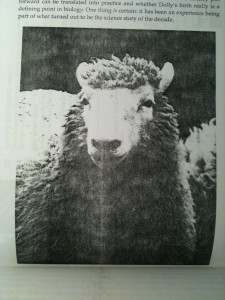1997 was quite a significant year for the Roslin Institute with “’Dolly, the sheep, ‘…the first mammal cloned from a cell from an adult animal…generated an amazing amount of interest from the world’s media.” (Griffin, Harry. ‘Dollymania’, University of Edinburgh Journal, XXXVIII: 2, December 1997, GB237 Coll-1362/4/1476). And so, it’s been exciting to find articles in the offprints discussing her and the issues of cloning, biotechnology, ethics – Dr. Grahame Bulfield even wrote a report to Parliament on what this breakthrough means for science!
Harry Griffin, former Assistant Director (Science) at the Roslin Institute in 1997’s article, ‘Dollymania’ (cited above) provides an insider’s point of view of how Dolly was produced and the science and research involved. He writes,
Dolly was produced from cells that had been taken from the udder of a 6-year old Finn Dorset ewe and cultured for several weeks in the laboratory. Individual cells were then fused with unfertilised eggs from which the genetic material had been removed and 29 of these ‘reconstructed’ eggs – each now with a diploid nucleus from the adult animal – were implanted in surrogate Blackface ewes. One gave rise to a live lamb, Dolly, some 148 days later. Other cloned lambs were derived in the same way by nuclear transfer from cells taken from embryonic and foetal tissue.
…
On Monday, Dolly provided the lead story in most of the papers and Roslin Institute was besieged by reporters and TV crews from all over the world…. Dolly rapidly became the most photographed sheep of all time and was invited to appear on a chat show in the US. Astrologers asked for her date of birth and PPL’s share price rose sharply. President Bill Clinton called on his bioethics’ commission to report on the ethical implications within 90 days and Ian Wilmut was invited to testify to both the UK House of Commons and the US Congress…. Dolly Parton sad she was ‘honoured’ that we have named our progeny after her and that there is no such thing as ‘baaaaaed publicity’. Sadly, we also received a handful of requests to resurrect relatives and loved pets.
 In the article, ‘Seven days that shook the world’ by Harry Griffin and Ian Wilmut in New Scientist, 22 March 1997 also describe the reality of the science of cloning in the face of intense media speculation and reportage.
In the article, ‘Seven days that shook the world’ by Harry Griffin and Ian Wilmut in New Scientist, 22 March 1997 also describe the reality of the science of cloning in the face of intense media speculation and reportage.
Dr. Grahame Bulfield, former Director of the Roslin Institute, wrote several articles in 1997 on biotechnology, ethics, livestock and cloning. In some articles, he writes generally on the techniques of genetic engineering, genome analysis, and embryo manipulations and provides a biological context of these new technologies. (GB237 Coll-1362/4/1394 – 1400). He discusses Dolly more directly in the article, ‘Dit is pas het begin’ in the Dutch journal Natuur & Techniek, No. 8, 1997 (4/1376)  and The Roslin Institute and Cloning an address to the Parliamentary and Scientific Committee in Science in Parliament, Vol. 54, No. 5, September/October 1997 (4/1400). In this particular article he writes specifically about Dolly:
and The Roslin Institute and Cloning an address to the Parliamentary and Scientific Committee in Science in Parliament, Vol. 54, No. 5, September/October 1997 (4/1400). In this particular article he writes specifically about Dolly:
As you know we have been thrown into the middle of public debate recently with a considerable amount of public interest and concern about “Dolly”.  Over a period of about five days we had 3,000 telephone calls, 17 TV crews and we basically ground to a halt. We are perfectly aware now of the issues that are raised , and I don’t believe that a scientific organisation like ours can do anything buy try and be proactive in terms of communicating new biotechnology advances to the public and Government and ensuring the issues involved are widely debated.
Over a period of about five days we had 3,000 telephone calls, 17 TV crews and we basically ground to a halt. We are perfectly aware now of the issues that are raised , and I don’t believe that a scientific organisation like ours can do anything buy try and be proactive in terms of communicating new biotechnology advances to the public and Government and ensuring the issues involved are widely debated.

